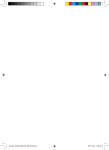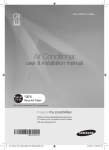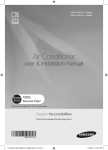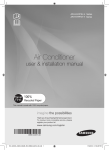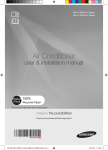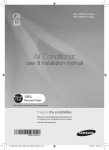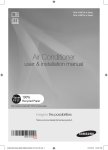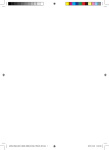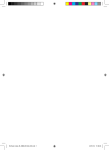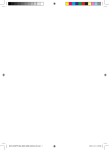Download A3050 EU_IM_DB68-04212A_HP_EN.indd 1 2013-10-23
Transcript
A3050 EU_IM_DB68-04212A_HP_EN.indd 1 2013-10-23 16:31:10 Contents Installation Safety precautions . . . . . . . . . . . . . . . . . . . . . . . . . . . . . . . . . . . . . . . . . . . . . . . . . . . . . . . . . . . . . . . . . . . . . . . . . . . . . . . . . . . . . . . . . . . . . . . . . . . . . . . . . . 3 Choosing the installation location . . . . . . . . . . . . . . . . . . . . . . . . . . . . . . . . . . . . . . . . . . . . . . . . . . . . . . . . . . . . . . . . . . . . . . . . . . . . . . . . . . . . . . . . . . . 4 Accessories . . . . . . . . . . . . . . . . . . . . . . . . . . . . . . . . . . . . . . . . . . . . . . . . . . . . . . . . . . . . . . . . . . . . . . . . . . . . . . . . . . . . . . . . . . . . . . . . . . . . . . . . . . . . . . . . . 7 Fixing the installation plate . . . . . . . . . . . . . . . . . . . . . . . . . . . . . . . . . . . . . . . . . . . . . . . . . . . . . . . . . . . . . . . . . . . . . . . . . . . . . . . . . . . . . . . . . . . . . . . . . 9 Disassembling/Assembling the Cover panel for indoor unit installation . . . . . . . . . . . . . . . . . . . . . . . . . . . . . . . . . . . . . . . . . . . . . . . . . . . . . 10 Connecting the assembly cable . . . . . . . . . . . . . . . . . . . . . . . . . . . . . . . . . . . . . . . . . . . . . . . . . . . . . . . . . . . . . . . . . . . . . . . . . . . . . . . . . . . . . . . . . . . . 12 Installing and connecting the assembly pipe of the indoor unit . . . . . . . . . . . . . . . . . . . . . . . . . . . . . . . . . . . . . . . . . . . . . . . . . . . . . . . . . . . . . 14 Evacuating the indoor unit . . . . . . . . . . . . . . . . . . . . . . . . . . . . . . . . . . . . . . . . . . . . . . . . . . . . . . . . . . . . . . . . . . . . . . . . . . . . . . . . . . . . . . . . . . . . . . . . . 15 Cutting or extending the pipe . . . . . . . . . . . . . . . . . . . . . . . . . . . . . . . . . . . . . . . . . . . . . . . . . . . . . . . . . . . . . . . . . . . . . . . . . . . . . . . . . . . . . . . . . . . . . 15 Installing and connecting the drain hose of the indoor unit . . . . . . . . . . . . . . . . . . . . . . . . . . . . . . . . . . . . . . . . . . . . . . . . . . . . . . . . . . . . . . . . . 17 Changing direction of the drain hose . . . . . . . . . . . . . . . . . . . . . . . . . . . . . . . . . . . . . . . . . . . . . . . . . . . . . . . . . . . . . . . . . . . . . . . . . . . . . . . . . . . . . . 18 Installing and connecting the drain hose of the outdoor unit . . . . . . . . . . . . . . . . . . . . . . . . . . . . . . . . . . . . . . . . . . . . . . . . . . . . . . . . . . . . . . . 19 Evacuating the connected pipes . . . . . . . . . . . . . . . . . . . . . . . . . . . . . . . . . . . . . . . . . . . . . . . . . . . . . . . . . . . . . . . . . . . . . . . . . . . . . . . . . . . . . . . . . . . 19 Performing the gas leak tests . . . . . . . . . . . . . . . . . . . . . . . . . . . . . . . . . . . . . . . . . . . . . . . . . . . . . . . . . . . . . . . . . . . . . . . . . . . . . . . . . . . . . . . . . . . . . . 22 Fixing the indoor unit in place . . . . . . . . . . . . . . . . . . . . . . . . . . . . . . . . . . . . . . . . . . . . . . . . . . . . . . . . . . . . . . . . . . . . . . . . . . . . . . . . . . . . . . . . . . . . . 23 Fixing the outdoor unit in place . . . . . . . . . . . . . . . . . . . . . . . . . . . . . . . . . . . . . . . . . . . . . . . . . . . . . . . . . . . . . . . . . . . . . . . . . . . . . . . . . . . . . . . . . . . . 23 Smart Install mode . . . . . . . . . . . . . . . . . . . . . . . . . . . . . . . . . . . . . . . . . . . . . . . . . . . . . . . . . . . . . . . . . . . . . . . . . . . . . . . . . . . . . . . . . . . . . . . . . . . . . . . . 24 Final check and trial operation . . . . . . . . . . . . . . . . . . . . . . . . . . . . . . . . . . . . . . . . . . . . . . . . . . . . . . . . . . . . . . . . . . . . . . . . . . . . . . . . . . . . . . . . . . . . . 26 Pump down procedure (when removing the product) . . . . . . . . . . . . . . . . . . . . . . . . . . . . . . . . . . . . . . . . . . . . . . . . . . . . . . . . . . . . . . . . . . . . . 26 How to connect your extended power cables . . . . . . . . . . . . . . . . . . . . . . . . . . . . . . . . . . . . . . . . . . . . . . . . . . . . . . . . . . . . . . . . . . . . . . . . . . . . . . 27 Sub PCB installation(optional) . . . . . . . . . . . . . . . . . . . . . . . . . . . . . . . . . . . . . . . . . . . . . . . . . . . . . . . . . . . . . . . . . . . . . . . . . . . . . . . . . . . . . . . . . . . . . 28 English-2 A3050 EU_IM_DB68-04212A_HP_EN.indd 2 2013-10-23 16:31:10 Safety precautions Carefully follow the precautions listed below because they are essential to guarantee the safety of the equipment. • Always disconnect the air conditioner from the power supply before servicing it or accessing its internal components. • Verify that installation and testing operations are performed by qualified personnel. • Verify that the air conditioner is not installed in an easily accessible area. General information Carefully read the content of this manual before installing the air conditioner and store the manual in a safe place in order to be able to use it as reference after installation. For maximum safety, installers should always carefully read the following warnings. Store the operation and installation manual in a safe location and remember to hand it over to the new owner if the air conditioner is sold or transferred. This manual explains how to install an indoor unit with a split system with two SAMSUNG units. The use of other types of units with different control systems may damage the units and invalidate the warranty. The manufacturer shall not be responsible for damages arising from the use of non compliant units. This product has been determined to be in compliance with the Low Voltage Directive (2006/95/EC), and the Electromagnetic Compatibility Directive (2004/108/EC) of the European Union. The manufacturer shall not be responsible for damage originating from unauthorized changes or the improper connection of electric and requirements set forth in the “Operating limits” table, included in the manual, shall immediately invalidate the warranty. The air conditioner should be used only for the applications for which it has been designed: the indoor unit is not suitable to be installed in areas used for laundry. Do not use the units if damaged. If problems occur, switch the unit off and disconnect it from the power supply. In order to help prevent electric shocks, fires or injuries, always stop the unit, disable the protection switch and contact SAMSUNG’s technical support if the unit produces smoke, if the power cable is hot or damaged or if the unit is very noisy. Always remember to inspect the unit, electric connections, refrigerant tubes and protections regularly. These operations should be performed by qualified personnel only. The unit contains moving parts, which should always be kept out of the reach of children. Do not attempt to repair, move, alter or reinstall the unit. If performed by unauthorized personnel, these operations may cause electric shocks or fires. Do not place containers with liquids or other objects on the unit. All the materials used for the manufacture and packaging of the air conditioner are recyclable. The packing material and exhaust batteries of the remote controller(optional) must be disposed of in accordance with current laws. The air conditioner contains a refrigerant that has to be disposed of as special waste. At the end of its life cycle, the air conditioner must be disposed of in authorized centers or returned to the retailer so that it can be disposed of correctly and safely. Installing the unit IMPORTANT: When installing the unit, always remember to connect first the refrigerant tubes, then the electrical lines. Always disassemble the electric lines before the refrigerant tubes. Upon receipt, inspect the product to verify that it has not been damaged during transport. If the product appears damaged, DO NOT INSTALL it and immediately report the damage to the carrier or retailer (if the installer or the authorized technician has collected the material from the retailer.) English-3 A3050 EU_IM_DB68-04212A_HP_EN.indd 3 2013-10-23 16:31:10 Safety precautions After completing the installation, always carry out a functional test and provide the instructions on how to operate the air conditioner to the user. Do not use the air conditioner in environments with hazardous substances or close to equipment that release free flames to avoid the occurrence of fires, explosions or injuries. To help prevent injury when accidentally touching the indoor unit fan, install the indoor unit at least 2.5 m above the floor. The air conditioner should be used only for the applications for which it has been designed : the indoor unit is not suitable to be installed in areas used for laundry. Our units must be installed in compliance with the spaces indicated in the installation manual to ensure either accessibility from both sides or ability to perform routine maintenance and repairs. The units’ components must be accessible and that can be disassembled in conditions of complete safety either for people or things. For this reason, where it is not observed as indicated into the Installation Manual, the cost necessary to reach and repair the unit (in safety, as required by current regulations in force) with slings, trucks, scaffolding or any other means of elevation won’t be considered in-warranty and charged to end user. Power supply line, fuse or circuit breaker Always make sure that the power supply is compliant with current safety standards. Always install the air conditioner in compliance with current local safety standards. Always verify that a suitable grounding connection is available. Verify that the voltage and frequency of the power supply comply with the specifications and that the installed power is sufficient to ensure the operation of any other domestic appliance connected to the same electric lines. Always verify that the cut-off and protection switches are suitably dimensioned. Verify that the air conditioner is connected to the power supply in accordance with the instructions provided in the wiring diagram included in the manual. Always verify that electric connections (cable entry, section of leads, protections…) are compliant with the electric specifications and with the instructions provided in the wiring scheme. Always verify that all connections comply with the standards applicable to the installation of air conditioners. Choosing the installation location Indoor unit For Wi-Fi Air-conditioner installation, select indoor unit location near to wireless router. In case Wi-Fi signal strength weakened , Smart APP may be disconnected depending on the Wi-Fi signal strength. Where airflow is not blocked. Where cool air can be distributed throughout the room. Install the refrigerant piping length and the height difference of both indoor and outdoor units as indicated in the installation diagram. Wall that prevents vibration and is strong enough to hold the product weight. Out of the direct sunlight . 1 m or more away from the TV or radio (to prevent the screen from being distorted or noise from being generated). As far away as possible from the fluorescent and incandescent lights (so that the remote controller can be operated well). A place where the air filter can be replaced easily. Don't install directly above electronics equipment as leaking water may cause damage if not serviced. (eg. Computers, TV, etc). English-4 A3050 EU_IM_DB68-04212A_HP_EN.indd 4 2013-10-23 16:31:10 Outdoor Unit Where it is not exposed to strong wind Well ventilated and dustless places Where possible keep out of sunlight and rain Where neighbors are not annoyed by operation sound or hot air Solid wall or support that prevents vibration and is strong enough to hold the product weight Where there is no risk of flammable gas leakage When installing the unit at a high place be sure to fix the unit legs 3 m or more away from the TV or radio (to prevent the screen from being distorted or noise from being generated) Install the unit horizontally Place where drained water does not become any problem. Place with no plants (especially climbing plants) and where small animal can not access. Outdoor unit should not be place higher than 2.4 m or directly under eaves for accessibility for service and OH&S reasons. • Avoid the following places to prevent malfunction of the unit - Where there is machine oil - Salty environment such as seaside areas - Where sulfide gas exists - Other special atmosphere areas If using a multi system, install as described in the installation manual supplied with the outdoor unit. 300 mm or more 125 mm or more Wrap the refrigerant pipes and the drain hose with the absorbent pad and vinyl tape. Refer to page 23 for further details. 125 mm or more You can select the direction of draining (left or right). 'L' m as maximum pipe length and 3 m as minimum pipe length. (It will reduce noise and vibration) 600 mm minimum 300 mm minimum 'L' meters maximum total pipe length 300 mm minimum 600 mm minimum 'H' meters maximum total pipe height Model 09/12 18/24 L 15 30 H 8 15 Make at least one round: It will help reduce noise and vibration. The appearance of the unit may be different from the diagram depending on the model. English-5 A3050 EU_IM_DB68-04212A_HP_EN.indd 5 2013-10-23 16:31:10 Choosing the installation location Space Requirements for Outdoor Unit If using a multi system, install as described in the installation manual supplied with the outdoor unit. When installing 1 outdoor unit Figure Description Top view Side view Air intake Air outlet Air intake Air outlet , Air flow direction. (Unit : mm) 1500 or more When 3 sides of the outdoor unit are blocked by the wall 300 or more When the air outlet is towards the wall 300 or more When the air outlet is opposite the wall 150 or more The upper part of the outdoor unit and the air outlet is opposite the wall When the walls are blocking front and the rear side of the outdoor unit 300 or more 300 or more 1500 or more 500 or more 2000 or more 1500 or more The upper part of the outdoor unit and the air outlet is towards the wall 600 or more When installing more than 1 outdoor unit (Unit : mm) 300 or more When 3 sides of the outdoor unit are blocked by the wall 1500 or more When the air outlet is towards the wall 300 or more 600 or more 600 or more 600 or more English-6 A3050 EU_IM_DB68-04212A_HP_EN.indd 6 2013-10-23 16:31:10 (Unit : mm) 500 or more 600 or more When the upper part of the outdoor unit and the air outlet is opposite the wall 300 or more 500 or more 600 or more 1500 or more 300 or more When the walls are blocking front and the rear side of the outdoor units 300 or more When front and rear side of the outdoor unit is towards the wall 1500 or more 600 or more 3000 or more 3000 or more 200 or more •If installation is done in inappropriate space, unit may generate sound and cause bad effect on the product. •Installation must be done in level and in a place where vibration will not cause any effect. Accessories The following accessories are supplied with the air conditioner: • The number of each accessory is indicated in parentheses. Accessories in the indoor unit case Installation Plate (1) Installation Plate (1) AR07/09/12HSSDB (03 frame) AR09/12HSSDA (04 frame) 18/24 (05 frame) Installation Manual (1) Wi-Fi Manual (1) Remote controller (1) Batteries for Remote controller (2) User’s Manual (1) M4 x 10 Tapped Screws(2) Cap Screws(3) Case Sub PCB ARHSSDB English-7 A3050 EU_IM_DB68-04212A_HP_EN.indd 7 2013-10-23 16:31:11 Accessories Accessories in the outdoor unit case If using a multi system, refer to the manual supplied with the outdoor unit. 2-wire 3-wire Assembly Cable (1) Assembly Cable (2) Drain Plug (1) Rubber Leg (4) •The flare nuts are attached to the end of each pipe of an evaporator or a service port. Use the nuts when connecting the pipes. •The assembly cable is optional. If it is not supplied, use the standard cable. •The drain plug and rubber leg are only included when the air conditioner is supplied without the assembly pipe as seen in the picture below. Optional accessories If using a multi system, refer to the manual supplied with the outdoor unit. The following connection accessories are optional. If they are not supplied, you should obtain them before installing the air conditioner. Insulated Insulated Assembly Insulated Assembly Insulated Assembly T3 Foam Tube Vinyl Tapes (2) Assembly Pipe, Pipe, Ø9.52mm (1) Pipe, Ø12.70mm (1) Pipe, Ø15.88mm (1) PEInsulation (1) Ø6.35mm (1) 09/12 18 24 Rubber Legs (4) Pipe Clamps A (3) Pipe Clamps B (3) Cement Nails (6) M4 x 25 Tapped Screws (6) Drain Hose, length 2m (1) Drain Plug (1) Putty 100g (1) Foam Insulation(1) • If these accessories are supplied, they will be in the accessory box. Tools required for installation General Tools • Vacuum Pump(Backward flowing prevention) • Torque Wrench • Pipe Cutter • Reamer • Screw Driver • Spanner • Drill • Manifold Gauge • Pipe Bender • L Wrench • Stud Finder • Spirit Level • Measuring Tape Tools for test operations • Thermometer • Resistance Meter • Electroscope English-8 A3050 EU_IM_DB68-04212A_HP_EN.indd 8 2013-10-23 16:31:11 Fixing the installation plate You can select the direction of the drain hose depending on where you want to install the indoor unit. Therefore before fixing the installation plate to a wall or a window frame, you must determine the position of the 65 mm hole through which the cable, pipe and hose pass to connect the indoor unit to the outdoor unit. When facing the wall, the pipe and cable can be connected from the: • • • • Direction of pipe Right (A) Left (B) Underside_right (C) Rear_right or left (D) B A D D C 1. Determine the position of the pipe and drain hose hole as seen in the picture and drill the hole with an inner diameter of 65 mm so that it slants slightly downwards. C D D B A Pipe hole (Ø65 mm) A Pipe hole (Ø65 mm) B C (Unit : mm) Model A B C D AR07/09/12HSSDB AR09/12HSSDA 0 241 30 0 18/24 5 161 52 5 •Make sure to drill only one hole after choosing the direction of the pipe. 2. Fix the indoor unit. If you fix the indoor unit on a wall (1) Fix the installation plate to the wall giving attention to the weight of the indoor unit. •If you mount the plate to a concrete wall using plastic anchors, make sure that gaps between the wall and the plate, created by projected anchor, is less than 20 mm. Plastic Anchor <20 mm Wall If you fix the indoor unit on a window frame (1) Determine the positions of the wooden uprights to be attached to the window frame. (2) Attach the wooden uprights to the window frame giving attention to the weight of the indoor unit. (3) Attach the installation plate to the wooden upright using tapping screws. If you fix the indoor unit on a gypsum board (1) Use stud finder to find out locations of the studs. (2) Fix the plate hanger on two studs. •Search for other spots if there are less than two studs, or the distance between the studs are different from the plate hanger. • Fix the installation plate without inclining to one side. •Make sure that a wall can withstand the weight of the product. If you install the product in a place where it is not strong enough to withstand the product weight, the unit could fall and cause injury. English-9 A3050 EU_IM_DB68-04212A_HP_EN.indd 9 2013-10-23 16:31:11 Disassembling/Assembling the Cover panel for indoor unit installation Please scan this QR code for detail video of indoor unit installation. In order to install the indoor unit, you must disassemble the cover panel first. Please proceed following instructions to disassemble and assemble the cover panel. Hooks (on the cover panel) may get damaged if you apply excessive force as you disassemble and assemble the cover panel. Please follow the following instructions. Removing the screws Cover panel is assembled on the bottom part of the indoor unit (as shown in the illustration) and it is fastened with screws. Remove the Cap screw first and unfasten the screws so that you can disassemble the cover panel. Cap Screw <Remove the Cap screw> Cover Panel <Unfasten the screw> Removing the Cover panel (Before mounting the indoor unit) Cover panel is fixed to a main body of the product with hooks on two sides and central part as shown in the illustration. Release the hooks on the sides first, and then release the hooks on the central part. Check the location of the hooks before removing the cover panel. ffLocation of the hooks on the central part Number and location of the hooks Side part Hook Central part For specific Hook location and quantity, please refer to cover panel with indicating arrows based on physical goods. English-10 A3050 EU_IM_DB68-04212A_HP_EN.indd 10 2013-10-23 16:31:12 ffRemoving the hooks on the side ffRemoving the hooks on the central part ① ② ① Caution (fragile) -- Gently press the both side of the cover panel inwards (①) and release the hooks on both sides(②). Caution (fragile) -- Use both hands -- Release each hook by pushing it up at an angle. Assembling the Cover panel (After mounting the indoor unit) To assemble the Cover panel, proceed in reverse order of disassembling. Use both hands for assembling and be extra careful not to damage the pipes and drain hose. Fix the hooks on the side and central part. Then fasten the screws and assemble the Cap screws. <Fix the hooks on side parts> <Fix the hooks on central part> <Fasten the screw> <Assemble the Cap screw> English-11 A3050 EU_IM_DB68-04212A_HP_EN.indd 11 2013-10-23 16:31:12 Connecting the assembly cable Cable specification If using a multi system, install as described in the installation manual supplied with the outdoor unit. Model Power cable 09/12 3G1.5mm² H07RN-F 18/24 3G2.5mm² H07RN-F Interconnection cable Type GL 3G1.0mm² H07RN-F 2x0.75mm² H05RN-F 3G1.0mm² H07RN-F 2x0.75mm² H05RN-F 20A 25A •Connect the power cable to the auxiliary circuit breaker. If every pole fails to connect to the power supply, it must be incorporated in a wire with a contact opening of ≥3 mm. •Use shield cable (Category 5; less than 50pF/m) for noisy environmental site. Connecting the cable Electrical work (1) For electrical and earth works, comply with the ‘technical standards of electrical installations’ and the the ‘wiring regulations’ of the Local wiring regulations. (2) Tighten the terminal block screw to under 1.2 N•m (12 kgf•cm). (3) Precautions when connecting terminal blocks of the indoor unit Before connecting, make sure the connecting part of the terminal socket is facing upwards. Upside down The terminal socketis damaged. There is no ring terminalto cover the wire. There must be no space between the terminal and the screw when connected. - Any remaining space may become a fire hazard due to overheating of the electrical contact. The terminal socket is upside down. Either the screw is not fitted properly or there is a space between the screw and the ring terminal. •For the terminal block wiring, use a wire with a ring terminal socket only. Regular wires without a ring terminal socket may become a fire hazard due to overheating of the electrical contact during a wiring work. When you install the unit, make first refrigerant connections and then electrical connections. Connect the air conditioner to grounding system before performing the electrical connection. If unit is uninstalled, first disconnect electrical cables, then refrigerant connections. If the outdoor unit is more than 4 or 5 meters away from the indoor unit, you must extend the cable. The maximum length of the cable is 15(09/12) / 30(18/24) meters. 1. Extend the assembly cable if necessary. •Do not connect two or more different cables to extend the length. It may cause fire. English-12 A3050 EU_IM_DB68-04212A_HP_EN.indd 12 2013-10-23 16:31:13 2 . Open the cover panel. 3 . Remove the screw securing the connector cover. 4 . Pass the assembly cable through the rear of the indoor unit and connect the assembly cable to terminals. (Refer to the picture below) •Each wire is labeled with the corresponding terminal number. 5 . 6 . 7 . 8 . 9. Pass the other end of the cable through the 65 mm hole in the wall. Close the connector cover by tightening the screw carefully. Close the cover panel. Remove the terminal board cover on the side of the outdoor unit. Connect the cables to the terminals as seen in the picture. •Each wire is labeled with the corresponding terminal number. Indoor unit Indoor unit 1(L) 2(N) F1 F2 1(L) 2(N) F2 F1 Outdoor unit L N F1 F2 Outdoor unit • Also circular terminal must be matched with screw size in terminal block. • After connecting the cables, make sure terminal numbers on the indoor/outdoor unit matches. •Please ensure that Power & Communication cables are separated, they must not be in the same cable. 10. Connect the grounding conductor to the grounding terminals. 11. Close the terminal board cover by tightening the screw carefully. •In Russia and Europe, consult with the supply authority to determine the supply system impedance before installation. •Connect the wires firmly so that wires can not be pulled out easily. (If they are loose, it could cause burn-out of the wires.) •Connect the wires according to color codes, referring to the wiring diagram. •The power cable and the interconnection cable should be selected according to the specification in page 12. English-13 A3050 EU_IM_DB68-04212A_HP_EN.indd 13 2013-10-23 16:31:13 Installing and connecting the assembly pipe of the indoor unit Connect indoor and outdoor units with field-supplied copper pipes by means of flare connections. Use insulated seamless refrigeration grade pipe only, (Cu DHP type according to ISO1337), degreased and deoxidized, suitable for operating pressures of at least 4200 kPa and for burst pressure of at least 20700 kPa. Under no circumstances must sanitary type copper pipe be used. There are 2 refrigerant pipes of different diameters: • The smaller one is for the liquid refrigerant • The larger one is for the gas refrigerant A short pipe is already fitted to the air conditioner. You may need to extend the pipe using the assembly pipe (optional). The connection procedure for the refrigerant pipe varies according to the exit position of the pipe when facing the wall: • Right(A) • Left(B) • Underside(C) • Rear B A 1. Cut out the appropriate knock-out piece (A, B, C) on the rear of the indoor unit unless you connect the pipe directly from the rear. 2. Smooth the cut edges. 3. Remove the protection caps of the pipes and connect the assembly pipe to each pipe. Tighten the nuts first with your hands, and then with a torque wrench, applying the following torque: C Outer Diameter N•m Torque kgf•cm ø6.35 mm 14~18 140~180 ø9.52 mm 34~42 350~430 ø12.70 mm 49~61 500~620 ø15.88 mm 68~82 690~830 • If you want to shorten or extend the pipes, refer to page 15~16. 4. Cut off the remaining foam insulation. 5. If necessary, bend the pipe to fit along the bottom of the indoor unit. Then pull it out through the appropriate hole. The pipe should not project from the rear of the indoor unit. The bending radius should be 100 mm or more. 6. Pass the pipe through the hole in the wall. 7. For further details on how to connect to the outdoor unit and evacuate the air, refer to page 19~21. •The pipe will be insulated and fixed permanently into position after finishing the installation and the gas leak test; refer to page 22 for further details. •Tighten the flare nut with torque wrench according to specified method. If the flare nut is over-tightened, the flare may break and cause refrigerant gas leakage. •DO NOT WALL UP THE PIPE CONNECTION ! All refrigerant pipe connection must be easy accessible and serviceable. English-14 A3050 EU_IM_DB68-04212A_HP_EN.indd 14 2013-10-23 16:31:13 Assembling the hanger screw Use 2 screws to fix the indoor unit as shown in the picture. Screw(M4x10) Evacuating the indoor unit The indoor unit is supplied with inert gas (nitrogen). Before installing the unit, check if nitrogen gas flow out of indoor unit. If this one isn’t true, DO NOT INSTALL THE UNIT since leakage could be inside the indoor unit. 1. Unscrew the caps at the end of each pipe. All inert gas exhausts from the indoor unit. •To prevent dirt or foreign substances from getting into the pipes during installation, do NOT remove the caps completely until you are ready to connect the pipes. •The remaining air in the Refrigeration cycle, which contains moisture, may cause malfunction on the compressor. •Always contact the service center or a professional installation agency for product installation. Pipes Unscrew the caps Cutting or extending the pipe The length of the pipe can be: • Extended up to : see table page 5 • Shorten up to: see page 5 If you need a pipe longer than 4 or 5 meters: • You must add refrigerant to the pipes; otherwise, the indoor unit may freeze. English-15 A3050 EU_IM_DB68-04212A_HP_EN.indd 15 2013-10-23 16:31:13 Cutting or extending the pipe 1. Make sure that you have all the required tools (pipe cutter, reamer, flaring tool and pipe holder). 2. If you want to shorten the pipe, cut it using a pipe cutter, ensuring that the cut edge remains at 90° with the side of the pipe (see below examples of correct and incorrect cut edges). Pipe cutter Oblique Rough Burr Pipe 3. To prevent a gas leak, remove all burrs at the cut edge of the pipe using a reamer. • Face the pipe down while removing the burrs to make sure that burrs do not get in to the pipe. 4. Put a flare nut slightly into the pipe and modify the flare. 90°± 2° B 45° ± 2° R 0.4~0.8 Pipe Outer Diameter (D) Depth (A) ø6.35 mm 1.3 mm Flaring Size (B) 8.7 - 9.1 mm ø9.52 mm 1.8 mm 12.8 - 13.2 mm ø12.70 mm 2.0 mm 16.2 - 16.6 mm ø15.88 mm 2.2 mm 19.3 - 19.7 mm Flare 5. Check if you flared the pipe correctly (see examples of incorrectly flared pipes below). Correct Inclined Damaged Surface Cracked Uneven Thickness 6. Align the pipes to connect them easily. Tighten the flare nuts first with your hands, and then with a torque wrench, applying the following torque: Flare nut Indoor outlet pipe Connecting pipe Outer Diameter ø6.35 mm ø9.52 mm ø12.70 mm ø15.88 mm Torque N•m 14~18 34~42 49~61 68~82 kgf•cm 140~180 350~430 500~620 690~830 •Excessive torque can be cause of gas leakage. If extending pipe by welding/brazing please ensure nitrogen is used during welding/brazing process. The joint must be accessible and serviceable. 7. For further details on how to connect to the outdoor unit and evacuate the air, refer to page 19~21. •Tighten the flare nut with torque wrench according to specified method. If the flare nut is over-tightened, the flare may break and cause refrigerant gas leakage. English-16 A3050 EU_IM_DB68-04212A_HP_EN.indd 16 2013-10-23 16:31:14 Installing and connecting the drain hose of the indoor unit When installing the drain hose for the indoor unit, check if condensation draining is adequate. When passing the drain hose through the 65 mm hole drilled in the wall, check the followings: Wall Indoor unit Drain hose The drain hose must NOT slant upwards. 5cm less The end of the drain hose must NOT be placed under water. The drain hose must not be bent. After completing the installation of the drain hose, pour water into the drain pan to check whether the hose is well drained. Ditch Keep a clearance of at least Do not place the end of the 5 cm between the end of the drain hose in a hollow. drain hose and the ground. Drain hose installation 1. If necessary, connect the 2 meter extension drain hose to the drain hose. 2. If you use the extension drain hose, insulate the inside of the extension drain hose with a shield. 3. Fit the drain hose into 1 of 2 drain hose holes, then fix the end of the drain hose tightly with a clamp. •If you do not use the other drain hose hole, block it with a rubber stopper. 4. When extending the Drain Hose, hold the end of Drain Hose and Extended Hose, rotate and insert the drain hose into Extended hose for 40~45 mm. Make sure the two hoses are firmly connected, there is no water leakage. Drain hose hole 5. Connect the Drain Hose after using Foam Insulation to wrap the Extended Hose. Then, Use vinyl tape to wrap the each side of connection by 20 mm . 40~45 mm Drain hose Extension drain hose Drain hose Extension drain hose 20 mm 20 mm or more or more Vinyl Tape Foam Insulation English-17 A3050 EU_IM_DB68-04212A_HP_EN.indd 17 2013-10-23 16:31:14 Installing and connecting the drain hose of the indoor unit 6. Pass the drain hose under the refrigerant pipe, keeping the drain hose tight. Shield 7. Pass the drain hose through the hole in the wall. Check if it slants downwards as seen in the picture. 8. Using natural drainage method, check the drainage is normal. Drain hose Extension drain hose •The hose will be fixed permanently into position after finishing the installation and the gas leak test; refer to page 22 for further details. •Make sure the installed direction of the drain hose is correct. Inadequate installation may cause condensate water leakage. •If the drain hose is routed inside the room, insulate the hose so that dripping condensation does not damage the furniture or floors. •DO NOT WALL UP THE DRAIN HOSE CONNECTION ! Drain hose connection must be easy accessible and serviceable. Changing direction of the drain hose Change the direction only when it is necessary. Screw hole Screw 1. Detach the rubber cap with the pliers. 2. Detach the drain hose by pulling it and turning to the left. 3. Insert the drain hose by fixing it with the screw into the groove of the drain hose and the outlet of the drain pan. 4. Attach the rubber cap with a screwdriver by turning it to the right until it fixes to the end of the groove. 5. Check for leakage on both side of the drain outlet. Pour the water in direction of arrow. Drain hose Drain pan outlet Rubber cap Direction of the drained water •Make sure the indoor unit is in upright position when you pour water to check for leakage. Make sure that the water does not overflow onto the electrical part. English-18 A3050 EU_IM_DB68-04212A_HP_EN.indd 18 2013-10-23 16:31:14 Installing and connecting the drain hose of the outdoor unit While heating, ice may accumulate. During the process of defrosting, check if condensation draining is adequate. For adequate draining, do the following. 1. Insert the drain plug into the drain hole on the underside of the outdoor unit. •To avoid drain plug from contacting the ground, secure gap between the ground and the bottom surface of the outdoor unit. Drain plug Drain hole Bottom surface of outdoor unit 2. Connect a drain hose to the drain plug. Drain hole Drain plug 3. Ensure that condensation draining is adequate. Drain hose Snow-proof hood •In areas with heavy snow fall, piled snow could block the air intake. To avoid this incident, install a frame that is higher than estimated snow fall. In addition, install a snow-proof hood to avoid snow from piling on the outdoor unit. Estimated snow fall Frame Ground Evacuating the connected pipes If using a multi system, install as described in the installation manual supplied with the outdoor unit. The outdoor unit is loaded with sufficient R-410A refrigerant. Do not vent R-410A into atmosphere: it is a fluorinated greenhouse gas, covered by Kyoto Protocol, with a Global Warming Potential (GWP) = 1975. You should evacuate the air in the indoor unit and in the pipe. If air remains in the refrigerant pipes, it affects the compressor. It may cause reduction of cooling capacity and malfunction. Use Vacuum Pump as seen in the picture. •When installing, make sure there is no leakage. When recovering the refrigerant, ground the compressor first before removing the connection pipe. If the refrigerant pipe is not properly connected and the compressor works with the service valve open, the pipe inhales the air and it makes the pressure inside of the refrigerant cycle abnormally high. It may cause explosion and injury. English-19 A3050 EU_IM_DB68-04212A_HP_EN.indd 19 2013-10-23 16:31:14 Evacuating the connected pipes 1. Connect each assembly pipe to the appropriate valve on the outdoor unit and tighten the flare nut. Outdoor unit Indoor unit Gas pipe side 2. Tighten the flare nut first with your hands, and then with a torque wrench, applying the following torque. Liquid pipe side • Excessive torque can be cause of gas leakage. Outer Diameter •Make the electrical connection and leave the system into “stand by mode”. Do not turn on the system! This is necessary for better vacuum operation (full OPEN position of Electronic Expansion Valve - EEV -). ø6.35 mm ø9.52 mm ø12.70 mm ø15.88 mm 3. Connect the charging hose of the low-pressure side of manifold gauge to a gas service port as seen in the picture. Torque N•m kgf•cm 14~18 140~180 34~42 350~430 49~61 500~620 68~82 690~830 Manifold gauge 4. Open the valve of the low pressure side of manifold gauge counterclockwise. 5. Evacuate the air in the connected pipes using the vacuum pump for about 15 minutes. Make sure that pressure gauge shows -0.1 MPa(-76 cmHg) after about Valve Gas service port <Low pressure> 10 minutes. This procedure is very important to avoid a gas leak. Close the valve of the low pressure side of manifold gauge clockwise. Turn off the vacuum pump. Check for 2 minutes if there is any pressure change. Remove the hose of the low pressure side of manifold gauge. Liquid service port <High pressure> Vacuum Pump (Backward flowing prevention) 6. Set a valve cork of liquid and gas service port to the open position. Adding Refrigerant Add refrigerant charge according to table below: If you use a pipe longer than 4 or 5 m, ‘15’ g of refrigerant R-410A must be added for each extra meter. If you use a pipe shorter than 4 or 5 m, The evacuate time is normal. Refer to the Service Manual for further details. •The remaining air in the Refrigeration cycle, which contains moisture, may cause malfunction on the compressor. •Always contact the service center or a professional installation agency for product installation. English-20 A3050 EU_IM_DB68-04212A_HP_EN.indd 20 2013-10-23 16:31:15 Important information regulation regarding the refrigerant used This product contains fluorinated greenhouse gases covered by the Kyoto Protocol. Do not vent gases into the atmosphere. 1. Please fill in with indelible ink, Refrigerant type R-410A GWP value 1975 GWP=Global Warming Potential Contains fluorinated greenhouse gases covered by the Kyoto Protocol. the factory refrigerant charge of the product, the additional refrigerant amount charged in the field and + the total refrigerant charge. on the refrigerant charge label Indoor unit supplied with the product. a. F actory refrigerant charge of the product: see unit name plate b. Additional refrigerant amount charged in the field (Refer to the above information for the quantity of refrigerant replenishment.) c. Total refrigerant charge d. Refrigerant cylinder and manifold for charging d a = ( = ( b ) kg ) kg Outdoor unit + = ( ) kg c •The filled-out label must be adhered in the proximity of the product charging port (e.g. onto the inside of the stop valve cover). Charging the refrigerant under conditions of liquid by using a liquid pipe R-410A is a mixed type of refrigerant. It is necessary for recharging under conditions of liquid. When recharging refrigerant from the refrigerant cylinder to the equipment, follow the instructions below. 1. Before recharging, check whether the cylinder has a siphon or not. There are two ways to recharge the refrigerant. Cylinder with siphon Cylinder without siphon Siphon Charge the refrigerant standing the cylinder upright. Charge the refrigerant turning the cylinder upside down. •If R-410A refrigerant is charged with gas, the composition of the charged refrigerant changes and the characteristics of the equipment vary. •During the measuring operation of refrigerant quantity added use electronic scales. If cylinder doesn’t have syphon, upset it. English-21 A3050 EU_IM_DB68-04212A_HP_EN.indd 21 2013-10-23 16:31:15 Performing the gas leak tests If using a multi system, install as described in the installation manual supplied with the outdoor unit. Make sure to check for gas leaks before completing the installation process (connecting the assembly pipe and hose between indoor unit and outdoor unit, insulating the cables, hose and pipe, and fixing the indoor unit to the installation plate). A D C B Test part for outdoor unit Test part for indoor unit Tightening torque for body cap (Refer to the table) Before inspecting the leakage, use a torque wrench to close the cap for the service valve. (Comply with a tightening torque for each size of the diameter,and tighten the cap firmly to prevent any leakage.). To check for any possible leakage, insert inert gas into the pipes connected to indoor/outdoor units and check the connection part of the indoor/outdoor units with soap lather or liquid for leakage test. Spindle Charging core R-22: Diameter of the screw - 7/16-20UNF R-410A: Diameter of the screw - 1/2-20UNF Tightening torque for charging port cap (Refer to the table) To check for gas leaks on the outdoor unit, Check the valve A and B using a leak detector. To check for gas leaks on the indoor unit, Check the flare nut C and D using a leak detector. Outer Diameter (mm) Tightening torque Body cap (N•m) Charging port cap (N•m) 20 ~ 25 20 ~ 25 25 ~ 30 30 ~ 35 35 ~ 40 10 ~ 12 ø 6.35 ø 9.52 ø12.70 ø15.88 ø19.05 ( 1 N•m = 10 kgf•cm ) Leak test with nitrogen (before opening valves) In order to detect basic refrigerant leaks, before recreating the vacuum and recirculating the R-410A, it’s responsible of installer to pressurize the whole system with nitrogen (using a cylinder with pressure reducer) at a pressure above 40 bar (gauge). Leak test with R-410A (after opening valves) Before opening valves, discharge all the nitrogen from the system and create vacuum according to page 19~21. After opening valves, check leaks using a leak detector for refrigerant. Pump down (before disconnecting the refrigerant connections for unit repair, removal or disposal) Pump-down is an operation intended to collect all the system refrigerant in the outdoor unit. This operation must be carried out before disconnecting the refrigerant tubing in order to avoid refrigerant loss to the atmosphere. Shut off the liquid valve with the Allen wrench. Turn the system on in cooling with fan operating at high velocity. (Compressor will immediately start, provided 3 minutes have elapsed since the last stop). After 2 minutes of operation, shut the suction valve with the same wrench. Turn the system off and switch mains supply off. Disconnect tubing. After disconnection, protect valves and tubing ends from dust. Compressor damage may occur if run at a negative suction pressure. English-22 A3050 EU_IM_DB68-04212A_HP_EN.indd 22 2013-10-23 16:31:15 Fixing the indoor unit in place Perform the following work on the area where gas leak test was done priory. After checking for gas leaks in the system, insulate the pipe, hose and cables. Then place the indoor unit on the installation plate. Insulation 1. To minimise condensation problems, wrap foam insulation (as shown in the figure) on a part without insulation on the end of the pipes. Pipes 2. Wind the pipe, assembly cable and drain hose with vinyl tape. 3. Place the bundle (the pipe, assembly cable and drain hose) in the lower part of the indoor unit carefully so it does not project from the rear of the indoor unit. 4. Hook the indoor unit to the installation plate and move the unit to the right and left until it is securely in place. Installation plate Vinyl tape Connecting pipes Connecting wires •Make sure pipe does not move when you install the indoor unit on an installation plate. Drain hose 5. Wrap the rest of the pipe with vinyl tape. 6. Attach the pipe to the wall using clamps (optional). Fixing the outdoor unit in place 1. Place the outdoor unit as indicated on the top of the unit to let the discharged air out properly. 2. Fix the outdoor unit in level to an appropriate support using anchor bolts. 3. If the outdoor unit is exposed to strong winds, install shield plates around the outdoor unit so that the fan can operate correctly. • Secure the rubber leg to help prevent the generation of noise and vibration. 'X' mm 'Y' mm Install the outdoor unit in level on a stable base to help avoid the generation of noise and vibration, especially when installing the unit close to a neighbor. If you install the outdoor unit in a place exposed to strong winds or at a height, fix it to an appropriate support (wall or ground). Rubber leg Model 09/12 AJ040/050 18/24 AJ052/060/ 070/080 AJ100 X 507 612 Y 292 317 660 340 620 360 Outdoor unit installed on the wall by rack •Ensure the wall will be able to suspend the weight of rack and outdoor unit; •Install the rack close to the column as much as possible; •Install proper grommet in order to help reduce noise and residual vibration transferred by outdoor unit towards wall. Designed to cut off residual vibration from outdoor unit to rack. (not supplied with product) Soft rubber designed to cut off vibration from rack to wall. (not supplied with product) English-23 A3050 EU_IM_DB68-04212A_HP_EN.indd 23 2013-10-23 16:31:15 Smart Install mode If using a multi system, install as described in the installation manual supplied with the outdoor unit. This model supports Smart Install mode which checks installation status to find out if there is any problems with any of the functions. Execute Smart Install mode after installation. 1. Check the installation status of the air conditioner. 1) Check the power supply, service valve (if it's open), power cable of the indoor and outdoor unit and amount of additional refrigerant required for pipe extension. 2) Status of the indicator after supplying the power : Standby status 2. When the air conditioner is in standby status, use the remote controller to start the Smart Install mode. 1) Press the [Set/Cancel or Cancel], [Mode], [Power] button simultaneously for 4 seconds. ffSmart Install mode can be operated only with the supplied remote controller. Remote controller may be different (image/functions) depending on the model. English-24 A3050 EU_IM_DB68-04212A_HP_EN.indd 24 2013-10-23 16:31:16 2) Smart Install mode in progress • 88 Display : Progress will be diplayed in 0~99. • LED Display : Indicator on the indoor unit display will blink in sequence and then all indicators will blink. (This will be repeated.) TYPE 88 Display LED Display LED 1 LED 2 LED 3 Indoor unit indicator Display may be different depending on the model. 3. Smart Install mode will end. 1) Smart Install mode will take approximately 7~13 minutes. (Actual time may be different depending on the model.) 2) When Installation is successful : Smart Install mode will end with ringing sound and the air conditioner will be in standby status. (Error message will not be displayed on the indoor unit indicator and the remote controller and buttons on the indoor unit will work normally.) 3) When installation is not successful : Smart Install mode will end and error message will be displayed on the indoor unit display. 1. Take necessary measures when error occurs. -- Refer to the service manual for necessary measures for each error that occurs. 2. Use the product after taking care of the error that occurs. Error indicator LED Display LED 1 LED 2 Display / , Error LED 3 Measures to take by an installer / Error on indoor temperature sensor 1.Check the connection of the connector Error on indoor heat exchanger 1.Check the connection of the connector Error on indoor fan motor 1.Check the connection of the connector 2.Remove foreign substance (Check for the cause that restrains motor) 1.Re-set options display and all LED blinks EEPROM/Option error , EEV or Valve Close error-Self diagnosis (blockage error/ refrigerant leakage) : Off / : Blinking / 1.Check if the service valve is open 2.Check for refrigerant leakage (pipe connections, heat exchanger) and charge refrigerant if necessary 3.Check if there's any blockage on refrigerant cycle (indoor unit/outdoor unit) 4.Check if additional refrigerant has been added after pipe extension : On English-25 A3050 EU_IM_DB68-04212A_HP_EN.indd 25 2013-10-23 16:31:16 Final check and trial operation To complete the installation, perform the following checks and tests to ensure that the air conditioner operates correctly. Check the followings: • Strength of the installation site • Tightness of pipe connection to detect gas leak • Electric wiring connection • Heat-resistant insulation of the pipe • Drainage • Grounding conductor connection • Correct operation (follow the steps below) 1. Press the Power button and check the following: The indicator on the indoor unit lights up. The airflow blade opens and the fan gears up for operation. 2. Press the Mode button to select Cool or Heat mode. In Cool mode, use In Heat mode, use Temp hr. + or – button and set the temperature at 16 °C. Temp hr. + or – button and set the temperature at 30 °C. •Approximately 3~5 minutes later, outdoor unit will start to operate and the Cool or Warm air will blow out. •After 12 minutes of stationary condition check the indoor unit air treatment. Cooling mode (indoor unit check) Inlet air temp. - Outlet air temp: From 10 °C to 12 °C (indicative delta T) Heating mode (indoor unit check) Outlet air temp. - Inlet air temp: From 11 °C to 14 °C (indicative delta T) In heating mode, the indoor fan motor can remain off to avoid cold air blown into conditioned space. 3. Press the Air swing button and check the following: The airflow blades work properly. 4. Press the Power button to stop the operation. •When you complete the installation successfully, hand over this manual to the user for storage in a handy and safe place. Pump down procedure (when removing the product) 1. Press the Power button on the indoor unit for 5 seconds. Beep will sound immediately to let you know that the product is ready for pump down procedure. 2 . Release the valve caps on High and Low pressure side. 3 . Use L wrench to close the valve on the high pressure side. 4 . After approximately 2 minutes, close the valve on the low pressure side. 5 . Stop operation of the air conditioner. 6 . Disconnect the pipes. English-26 A3050 EU_IM_DB68-04212A_HP_EN.indd 26 2013-10-23 16:31:17 How to connect your extended power cables Items to prepare (compressor and insulation tape should be prepared by an installation technician.) Tools Spec Crimping pliers Connection sleeve (mm) Insulation tape Contraction tube (mm) MH-14 20xØ7.0(HxOD) Width 18 mm 50xØ8.0(LxOD) Shape 1. As shown in the figure, peel off the shields from the rubber/wire of the power cable. - Peel off 20 mm of the wire shields of the tube installed already. •After peeling off the tube wire, you must insert a contraction tube. (Unit: mm) Power cable (provided by us) 20 20 20 60 120 180 Wire tube power cable 20 2. Insert both sides of core wire of the power cable into the connection sleeve. Connection sleeve 3. Using a compressor, compress the two points and flip it over and compress another two points in the same location. - The compression dimension should be 8.0. - After compressing it, pull both sides of the wire to make sure it is firmly pressed. Comp. dim. Compress it 4 times 5 mm 4. Wrap it with the insulation tape twice and position your contraction tube in the middle of the insulation tape. 5. Apply heat to the contraction tube to contract it. Insulation tape 40 mm Contraction tube 6. After tube contraction work is completed, wrap it with the insulation tape to finish. Insulation tape •In case of extending the electric wire, please DO NOT use a round-shaped pressing socket. - Incomplete wire connections can cause electric shock or a fire. English-27 A3050 EU_IM_DB68-04212A_HP_EN.indd 27 2013-10-23 16:31:17 Sub PCB installation(optional) Only for multi system (Wried remote controller, central remote controller etc.) 1. Turn the power off and take off the cover panel of the indoor unit. 2. Attach the Sub PCB to the Case Sub PCB. 3. Assemble the Case Sub PCB to the indoor unit. 1(L) 2(N) F1 F2 Case Sub PCB Sub PCB 4. Find the PCB wire, and connect the wire to the Sub PCB as seen in the picture. 1(L) 2(N) F1 F2 5. Connect the wire(remote controller, central remote controller etc) to the Sub PCB. 1(L) 2(N) F1 F2 6. Assemble the Cover PCB and the front panel. •The Sub PCB is attached to be controlled by the wired remote controller and central controller. English-28 A3050 EU_IM_DB68-04212A_HP_EN.indd 28 2013-10-23 16:31:18 English-29 A3050 EU_IM_DB68-04212A_HP_EN.indd 29 2013-10-23 16:31:18 DB68-04212A-00 A3050 EU_IM_DB68-04212A_HP_EN.indd 30 2013-10-23 16:31:18 AR✴✴FSSSBWK ARHSFSSeries Series AR✴✴FSSSCUR ARHSFNSeries Series ARHSSD Series Air Conditioner user & installation manual This manual is made with 100% recycled paper. imagine the possibilities Thank you for purchasing this Samsung product. To receive more complete service, please register your product at www.samsung.com/register A3050 EU_IM_DB68-04212A_HP_EN.indd 31 2013-10-23 16:31:18































